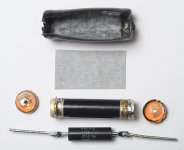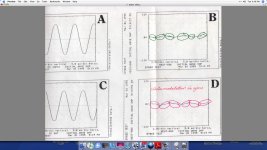Although I will built Scott's preamp at some point I've been looking around to see if there is a more 'Muntzed' MM pre out there. For the class of balanced not found anything yet, but the high octane from LA which is based on the old QUAD phono is 3 transistors and a current source. B&O used to do a module to plug into their turntables with only 2 active devices per channel, which is probably more simplified than one should go.
SY heard nothing. How tiresome, you have to be deaf not to hear the difference the oldest one in the books.
When SY was on a home concert in my house, he said that speakers were crossed over on 7 KHz. And he was right!
I should also note that one of my other projects currently adding to the list is a Flat MC preamp based on some work Wayne Kirkwood did testing the ZTX851 which H&H discovered are spectacularly low noise for a general purpose bipolar. Now as I've never looked closely at mic preamps before when he referenced the basic design from 'Demrow et al' I didn't think any more. Few months later decided to hunt out who 'et al' were and discovered Scott was one of them and this is basically a composite take on the AD524, which is viewed as a CFB design therefore should keep some here happy.
It's nice to join the dots, esp when you get near SOTA noise performance from 50p transistors and 80p 8legs 😀
But it is a shame that a topology that's been proven since the late 60s for microphone work has been largely ignored for phono duties, unless I have missed something, which I usually have.
It's nice to join the dots, esp when you get near SOTA noise performance from 50p transistors and 80p 8legs 😀
But it is a shame that a topology that's been proven since the late 60s for microphone work has been largely ignored for phono duties, unless I have missed something, which I usually have.
The Bybees are avalable in copper, silver, and gold versions. The wire that connects the .025 ohm resistor to the outside world is made from copper, silver, or gold and incrementally priced $100 to $160 a piece higher for each version,. This 1 inch wire on each side of the "Bybee" is shortened when attached to the equipment being treated. I expect the main elements of the resistor and treated core are the same in each version. The price difference for 2 inches of wire depending on which of the 3 metals chosen and that is often shortened during installation seems a bit much.
Last edited:
In 1970'Th I used a similar topology in a mic preamp, with a medium power transistor input.
"Everything new is well forgotten old" - Russian saying
Zetex just puts medium power transistors in small cases, instead of TO-220 where they were ordinarily.
"Everything new is well forgotten old" - Russian saying
Zetex just puts medium power transistors in small cases, instead of TO-220 where they were ordinarily.
Okay, but if I own a piece of audio gear that is so badly designed as to be perturbed by that tiny bit of crap on the incoming AC (assuming that's what we're looking at above), why haven't I punted it into the dumpster?
Maybe I'm just too new at this game, I've only been doing audio since 1980. Just what exactly are we supposed to do with this bybee device?
and what are the graphs on the more? page supposed to show, a little information would go a long way to being able to comment on it.
Alan
and what are the graphs on the more? page supposed to show, a little information would go a long way to being able to comment on it.
Alan
Maybe I'm just too new at this game, I've only been doing audio since 1980. Just what exactly are we supposed to do with this bybee device?
and what are the graphs on the more? page supposed to show, a little information would go a long way to being able to comment on it.
Alan
You're not supposed to comment on it; you're suppposed to drool and stare to the ground (tm) 😎
Jan
Okay, but if I own a piece of audio gear that is so badly designed as to be perturbed by that tiny bit of crap on the incoming AC (assuming that's what we're looking at above), why haven't I punted it into the dumpster?
Go ahead, punt it all away... it's not like things sound bad with Bybees. They're just extra.
I speculate maybe somehow Bybee's dampen something, especially based on the little graphs.
In 1970'Th I used a similar topology in a mic preamp, with a medium power transistor input.
"Everything new is well forgotten old" - Russian saying
So true. But the medium power transistors is nothing new in audio and Demrow's 1968 paper is now part of standard texts such as the handbook for sound engineers and yet ignored by boutique audio. I can only assume that, as balanced input phono stages are the mega-buck ones and you need a special story for mega-buck units it was overlooked.
Big thumbs up to H&H for actually buying piles of transistors and measuring them. Rbb of 2 Ohms is rather handy.
It's all good -- don't worry.
As far as needing peer review, to a degree, yes. It can be informal. We're not talking full blown studies and such (I'm an academic so I'm not asking for a "good" publication-quality document), but if you're going to make exceptional claims, and then don't back it up in a way that has a chance of being replicated, these assertions become very very problematic.
A couple of years ago a certified german calibration lab measured some Bybee devices and found afair measureable differences. Unfortunately only available in german (again afair), if there is some interest i´ll dig in my archive to find it.
Okay, but if I own a piece of audio gear that is so badly designed as to be perturbed by that tiny bit of crap on the incoming AC (assuming that's what we're looking at above), why haven't I punted it into the dumpster?
It isn´t meant offensive - i just take your post as starting point.
There is a recurring element in the argumentation wrt this sort of "questionable" audio gizmos:
1.) it´s impossible (theoretically; natural laws would be violated and so on...)
that it could make a difference
after showing that it can
2.) ok, it can, but in reality it will not
after showing that it will
3.) ok, but it can´t be measured
after showing that it can
4.) ok, it can be measured, but it can´t be heard
after showing that it can
5.) ok, the designer was incompetent 🙂
The last line is my favourite as it is obviously just a small step from "impossible" to "incompetence if not considered"....
Jakob: I would be interested in seeing the measurements if you can find them.
http://www.gecom-technologies.com/images/pdf/Bybee_Quantum_Purifier_Teil2.pdf
In this second part are the measurements from Gecom included, the first part was about general introduction, pros and cons of A/B blind comparisons 😉 and about different approaches to the evaluation of audio material.
This two part article was published in the Studio Magazine, all listeners are/were working in professional recording/mastering studios (beside publishing the Studio Magazine).
Not ment as an endorsemnet, just a description of the background of the acting people....
Last edited:
- Status
- Not open for further replies.
- Home
- Member Areas
- The Lounge
- John Curl's Blowtorch preamplifier part II



